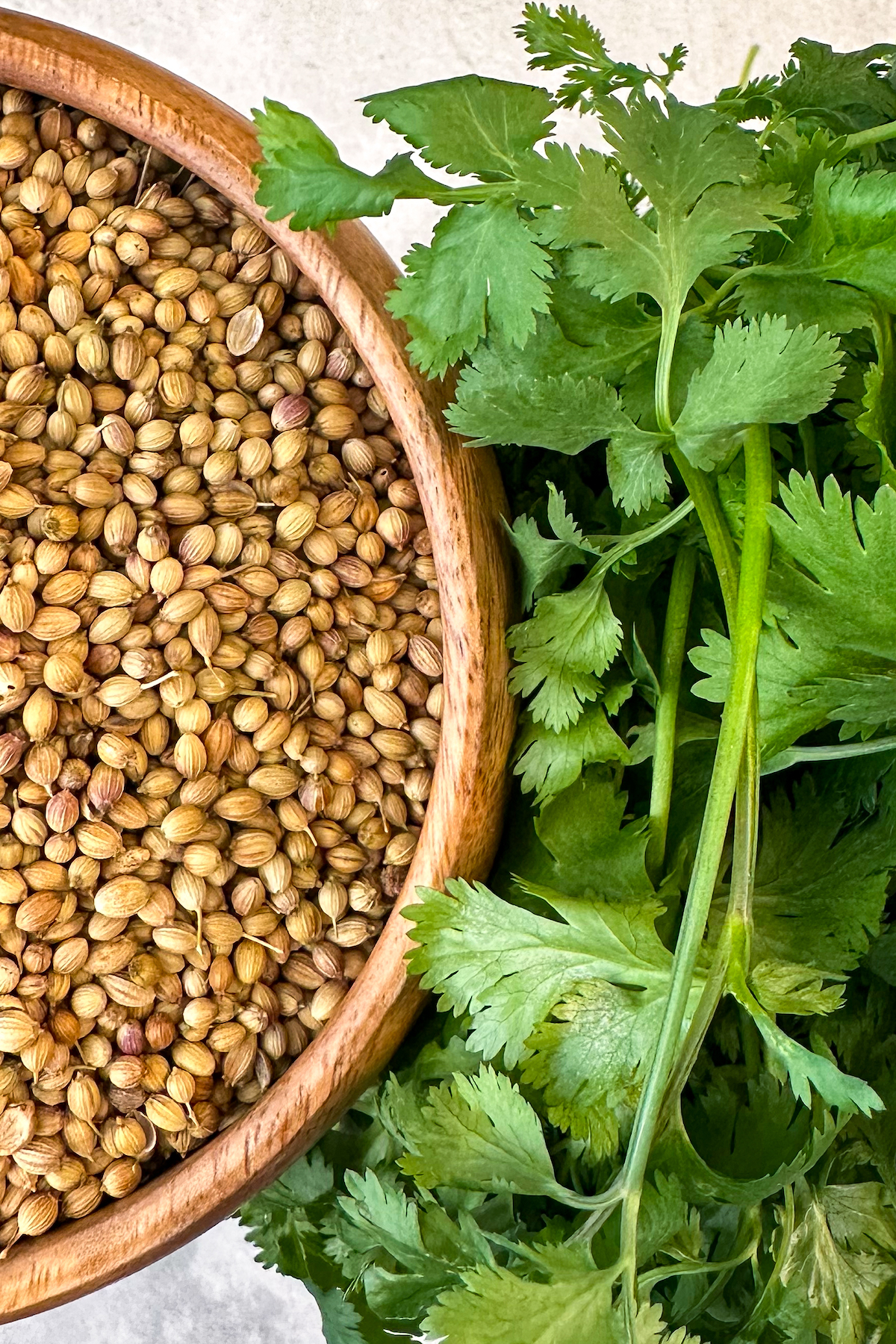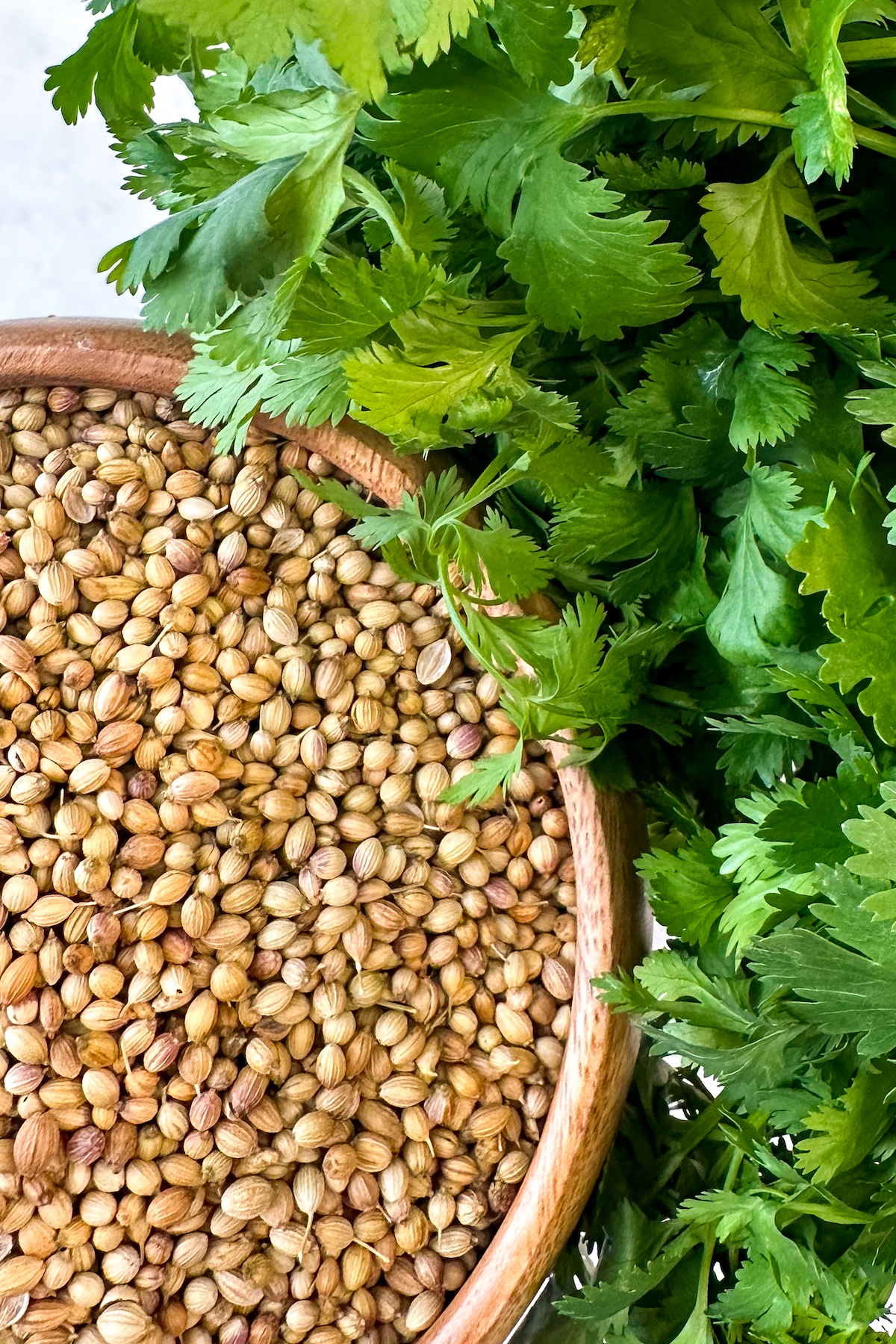Is Coriander the Same as Cilantro? While both of these ingredients come from the same plant, they may not be exactly the same thing – it all depends on where you are. Want to know more? Let’s dig in!

Are Coriander and Cilantro the Same Thing?
You’re looking at a recipe, and it calls for cilantro, and you wonder if that jar of ground coriander will work. Or maybe you have a bunch of leafy green herbs from the store labeled “coriander,” and you are wondering why a packet of seeds on the spice aisle has the same name! So, is coriander the same as cilantro?
The thing to know is that the terms “cilantro” and “coriander” are sometimes used interchangeably, because both come from the same plant – coriandrum sativum. They just go by different names, depending on what part of the world you are. Here’s the scoop.

What Is Cilantro?
“Cilantro” is the Spanish word for the leaves and stems of coriandrum sativum. This is why you will often see the same leafy greens labeled “cilantro” or “coriander.” In the United States, the leaves and stems of this plant are nearly always called cilantro. If you see a recipe calling for cilantro, that means you need the leaves and stems.

What Is Coriander?
Now let’s talk about coriander. Coriander is the name that Americans use for the seeds of the plant. But in other parts of the world, “coriander” means the seeds, leaves and stems. Usually, to make things a little easier, the recipe will say “fresh coriander” or “coriander seeds” to help you understand which one you need.
So, to recap: cilantro and coriander come from the same plant. Internationally, “coriander” is the name for both the herb (leaves and stems) and the spice (seeds). In the United States, the Spanish word “cilantro” is usually the name for the leaves and stems, while “coriander” is the name used for the seeds. (For the rest of this post, I’ll be using U.S. terminology to compare the leaves and seeds.)
Why Do Cilantro and Coriander Taste Different?
If you compare the two, you’ll notice that fresh cilantro tastes very different from coriander seeds. Just like the greens of root vegetables taste different than the roots themselves (think turnip greens vs. turnip roots, or beet greens vs. beet roots), the greens of this herb taste different than the seeds. Cilantro has a fresh, grassy, citrusy, herbal taste.
The seeds, on the other hand, are similar to other ground spices. They have a warm, earthy, slightly sweet flavor that’s even better toasted. In addition, not only is coriander warm and sweet, it also has a surprisingly lemony fragrance and taste, somewhat like Earl Grey tea.


What Does Cilantro Taste Similar To?
This is kind of a funny question, because we all know people who absolutely cannot eat cilantro. Others love it! Those who dislike this controversial herb often claim that it tastes like soap. Turns out, there’s a reason for this. According to genetics firm 23andMe, people who dislike cilantro’s “soapy” flavor have certain smell-receptor genes that detect the scent of chemicals called aldehydes. Aldehydes are naturally present in cilantro, but they are also used in soap making processes – which is why many people find the taste of cilantro too close to a bottle of dish soap.
For cilantro fans, this leafy herb is usually described as bright, fresh, and citrusy. It has a clean taste that’s almost peppery, and adds a punch of freshness to dishes that helps wake them up and cut through rich, fatty ingredients like pork shoulder or avocado.
Want to save this recipe?
Is Coriander the Same as Cumin?
You might be wondering if coriander seeds are the same as whole cumin, and while they may appear similar, they are not the same. Cumin seeds have an earthy taste that will be familiar to anyone who enjoys Mexican food or Southwestern food – it’s one of the primary ingredients in most chili seasonings, for example. But coriander will probably make you think more of Middle Eastern, Asian, or Mediterranean cuisine. It has a fruitier taste than cumin, with strong lemony notes.

How to Use Cilantro in Cooking
Fresh cilantro can be added to most savory recipes, either as an ingredient or a garnish. Sprinkle chopped cilantro on top of soups, stews, rice dishes, curries, tacos, enchiladas, and more. Make a Chimichurri Sauce with cilantro, add a ton of flavor to your rice with Cilantro Lime Rice, or use it in this Creamy Cilantro Lime Dressing. This hearty Crockpot Mexican Pozole is another great recipe that uses cilantro – hearty, yet fresh.


How to Use Coriander Seeds
Coriander seeds can be tossed whole into dishes like pickles and sauerkraut, as part of the brine. But for cooking, they are usually toasted and ground. Ground coriander is wonderful in curries, spice rubs, soups, rice dishes, and more. It’s used in Egyptian food, Indian cuisine, and lots of other recipes that call for toasted, ground spices. Try throwing this fragrant, sweet-and-citrusy spice into almost any savory dish that could use a little brightness.

How to Store Cilantro
While you can store coriander seeds the same way you would store most spices (airtight container, away from light and heat), what about cilantro? One of the best ways to store fresh cilantro is to store it like a bouquet of flowers. Place the cilantro in a small glass or jar with a couple of inches of water. Protect the leaves by covering them loosely with a baggie or some plastic wrap, and place the jar in the refrigerator. If stored this way, your fresh cilantro should last several days.
Post may contain affiliate links. Read my disclosure policy.


